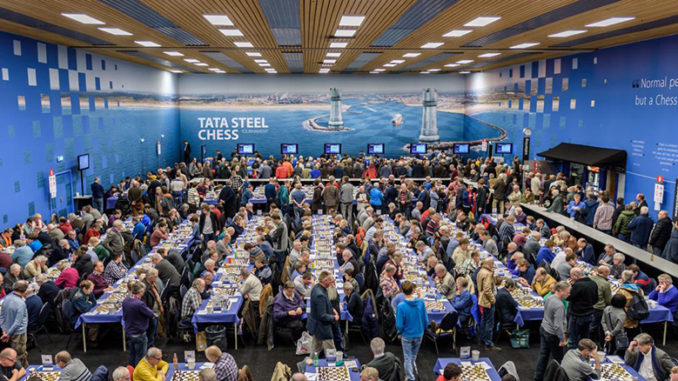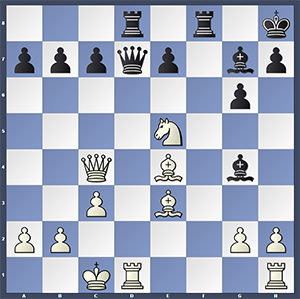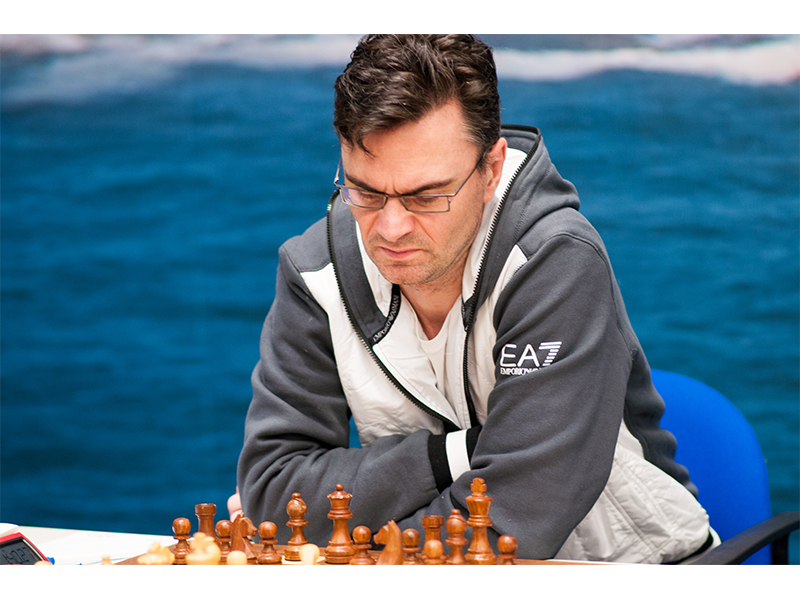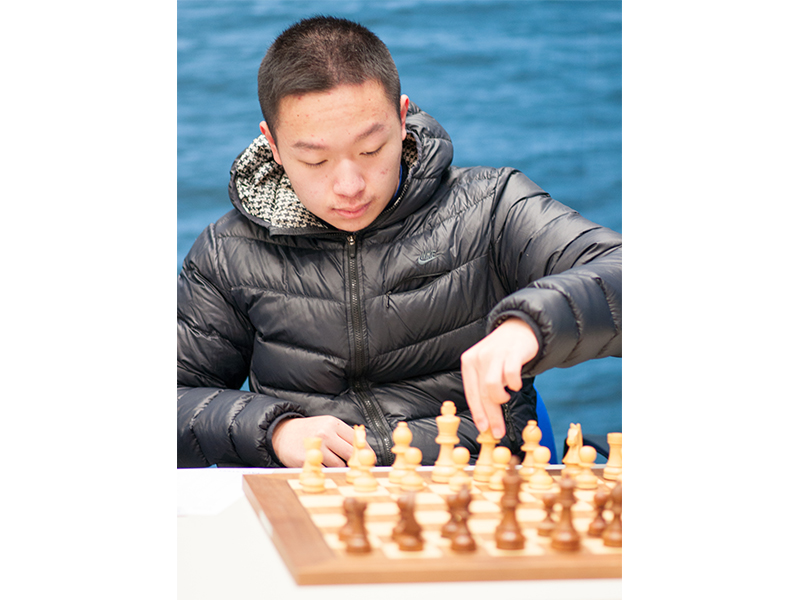
The third round of the Tata Steel Chess Tournament, was played on Monday January 16th, in Wijk aan Zee, Holland. It was a chess fan’s delight as the players came out with their sleeves rolled up and we saw a full round of fighting chess. The Masters group would see three games decided in a round where White ruled the day and there were a few self-inflicted wounds.
Yi Wei and Ian Nepomniachtchi got embroiled in the longest game of the day, which lasted 75-moves. It all came from a Sicilian Najdorf, with White taking a very rare move order, 10.Be2, which produces only one game in my database. After Black’s 10…e5, we were in new ground. Play took place on both wings, which made the game quite exciting. Black managed to bag a couple of pawns, but White obtained the better activity in compensation. The other factor was that Black had two isolated and doubled pawns on the e-file and a further isolated bit on the h-file.
Nepomniachtchi, under some pressure, then decided to sacrifice the exchange, rook for bishop, and this did him no favours. It left him with too much to defend and too little to do it with. White’s rooks proved superior in the situation compared to Black’s King and remaining rook and bishop, and this ultimately decided the day. One by one the pawns started to disappear until it was a losing rook versus bishop ending. In took some time to do so, but Wei converted very effectively.
Richard Rapport will be very disappointed following his game with Wesley So. The Hungarian very nearly ended So’s unbeaten run and with the Black pieces to boot. So admitted to not having played a very high quality game and he was quite lucky to escape, really. Unfortunately for his opponent, he was let off the hook.
The game was a Queen’s Indian and in all fairness, White’s play was far too slow and elaborate for his own good. It was well intended, setting up on the Kingside towards the Black King. Unfortunately it was also very time consuming and move by move, White seemed to help Black, who equalised without effort and didn’t really have to play any blinding moves in order to take the best of things.
24.Bc1(!) however, was a blinding move, which So admitted to having missed. It changed the game, for the most because So did not handle it at all well. His 25.Ng3(?) allowed Rapport to pick up the b2-pawn and seize a huge initiative. The problem for White, is that saving the b-pawn, with 25.b3 would have likely seen 25…Bb2 26.Nb5 and then 26…f5 really puts the cat among the pigeons. Should the Kingside explode, White’s King would be the more exposed. Even so, this seems preferable.
So soon found himself in a horrible situation, with the g-file open and Black’s rooks owning it. By contrast, his own rooks, though doubled along the h-file, were denied access by his own pawn and unable to challenge Black. 32…Rg2+ saw Black with a winning advantage, but after 33.Qb1, Black was a little too eager to bring his Queen into the action with 33…Qf7 and were he to have opted for …Rd2 instead, we may have seen a different result to this game. As it was, there then came the blunderous 34…Qg6, allowing 35.Ne7, forking Queen and rook. All of a sudden, the game flipped on its head and White was winning!
So comfortable was White’s position, that he was soon able to sacrifice the exchange, Queen for knight. In actual fact, he had already picked up rook, knight and pawn, so this saw him with a considerable profit. It left White with a pair of knights, rook, and 5 pawns versus Black’s Queen and 4 pawns. A very unpleasant situation for the Hungarian indeed. Soon, White’s pieces were poised to deliver mate and Black resigned. An unbelievable game, really, which neither player deserved to win and in the end, the one who made the last mistake lost. Such is chess.
Loek van Wely also had an unpleasant time of it, against Sergey Karjakin. Van Wely opted for the Pirc Defence and unfortunately wasn’t in the game for long. His 16…Nxe5(??) was a huge blunder, which after 17.Nxe5 saw him with nothing better than to exchange Queen for rooks. This was the best he could hope for, but was still losing. From the diagram, below, you can see that there was much worse possible, however, should he have attempted to avoid it. White’s Queen and knight are a lethal combination and Nf2+ would have brought all kinds of tragedy. The Dutchman fought bravely, but this proved fruitless at the end of the day and Karjakin converted without much problem.

The other games were drawn. Baskaran Adhiban opened with the London System against Levon Aronian, who had no problem in containing it. Exchanges happened rather steadily, and this reduced the sharpness in the position. White lined up on the Kingside, but there was no danger to Black, who also had his own potential on the Kingside. Aronian maneuvered his Queen into the Adhiban’s camp and then added his rook, the two pieces lining up along White’s back rank. Baskaran decided to take no risks and bailed with perpetual.
Pavel Eljanov and Pentala Harikrishna debated the English opening, but did not get very animated about it. White’s rook lift of 16.Rd3 in order to swing it over to the g-file with 19.Rg3 did not really produce anything for him. Black had everything covered and the players gradually exchanged down until there was a very simplified position and the point was split.
Dmitry Andreikin took to the Catalan in order to try to get one over on Magnus Carlsen. The World Champion’s 11…Nxe5 was a new move and worked out very well for him. He managed to equalise with no problem at all and was then better. 23.Ra3 Bb5 saw an opportunity for repetition, which Andreikin offered with 24.Rb3 and this was accepted by Carlsen with 24…Ra3 etc. and the players soon shook hands.
Radoslaw Wojtaszek and Anish Giri debated the Slav Defence, which saw Black deviate from known ground with the confrontational 14…e5. The game saw Black take space in the centre, while White Set up on the Queenside. Exchanging on d5, with 26.Bxd5, relinquishing his bishop pair, was possibly a little hasty for the Polish Grandmaster, it didn’t seem to work for him. 26.e3-e4 might have been a little more productive — ok, after 26…Ne3 he would have had to relinquish the bishop pair anyway, but 27.Bxe3 dxe3 with Rce1/Bd5/Bxe6 to follow seems a more favourable way of doing so. As it was, Black’s passer on the d-file was quite potent and needed dealing with and after that was resolved the players agreed a draw. Radoslaw told me that he found the game very interesting and a little crazy. He was not sure if he should be playing for advantage or not and seemed quite content with the draw.
This leaves Pavel Eljanov in the lead of the Masters Group after the third round, with the penultimate round before the first rest day coming up on Tuesday.
Masters Group Standings after Round 3.
Eljanov — 2.5
Harikrishna, Carlsen, Wei, So, Karjakin — 2
Aronian, Giri, Andreikin — 1.5
Nepomniachtchi, Wojtaszek, Adhiban — 1.0
Rapport, Van Wely — 0.5
Masters Group Round 4, Tuesday the 17th, 13:30 local time.
Aronian – Nepomniachtchi
Carlsen – Wei
Giri – Andreikin
Rapport – Wojtaszek
Van Wely – So
Harikrishna – Karjakin
Adhiban – Eljanov.
Markus Ragger leads the Challengers Group after a bloody round which saw all but one game decided.
Challengers Group Standings after Round 3.
Ragger — 3
Smirin — 2.5
Dobrov, Grandelius — 2
Xiong, Jones, Bok, Lu — 1.5
l’Ami, Tari, Hansen, Van Foreest, Lei — 1.0
Guramishvili — 0.5
Challengers Group Round 4, Tuesday the 17th, 13:30 local time.
Grandelius – Xiong
Lei – l’Ami
Hansen – van Foreest
Dobrov – Ragger
Lu – Bok
Jones – Tari
Guramishvili – Smirin.







